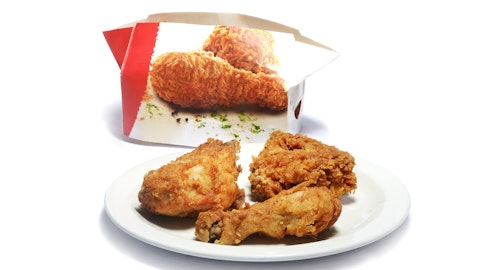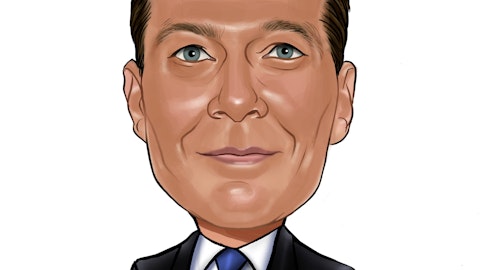Dennis Geiger: Great. Thanks, guys. I just wanted to ask a little bit more on the Smashed Jack. Clearly a great product, I think, for those of us fortunate enough to have tried it thus far. You saw great results there in the soft launch. I guess the question is specific to it being sort of on the premium end of the barbell strategy there. As you think about this environment where a portion of the industry consumer is acting a bit more cautiously, how do you think about that dynamic? Is this just that much of a hero new item based on what you’ve seen in soft launch that this is going to be that strong for however long? Do you do anything different around marketing the product, knowing maybe a portion of that customer base is a bit softer? Any kind of comments on Smashed Jack and then relative to the environment to add? Thank you.
Darin Harris: Yeah. Any day of the week I’ll take the best tasting product out there over the competition. And so I think from a differentiation standpoint, Smashed Jack is that differentiated and that much tastier than a lot of what’s out there in the marketplace. So we feel really good about what Smashed Jack can do to our business. So I think it does have the ability to overcome some of the challenges that we see with the consumer just because the product is so good. That’s what we saw in test. It’s what we saw in our soft launch. And we believe that it can help us throughout the year really outperform what we anticipate with some of the headwinds that we’re facing right now. So Smashed Jack is by far something that we are leaning into and very excited about. And we can’t wait to roll out our marketing campaign where we really tell an authentic story about what Jack has done differently with the burger to make it the best in QSR.
Dennis Geiger: Appreciate it. Thanks, Darin.
Operator: Our next question comes from the line of Alex Slagle with Jefferies. Please go ahead.
Alexander Slagle: Thanks, guys. Do you think there’ll be additional opportunities like the nine units you took over in Detroit where you sort of end up with the small portfolio involving markets again that you fixed up and refranchised? It didn’t seem like you were heading that way or that was on the radar at this point, but curious if you think there’s more opportunity there.
Darin Harris: I’ll let Brian handle this question.
Brian Scott: Yeah. This was a very unique situation. As you know, we’re on a path towards refranchising Del Tacos. And as we mentioned in prepared remarks, we actually just signed a deal and have another one in the works here. In this particular case, it’s a good market. We happen to have a franchise operator that wanted to disengage from the franchise. And so we took it back now. We’re already seeing improving trends as we’ve invested more in operations and extending hours and are absolutely intent to, at some point, refranchise that market. So we don’t really look at this as a new trend that we’re going to start to take back more restaurants, but in a case like this, we absolutely think it’s a good market to be in. We can grow. And the next operator that we partner with there, we think, will grow that market as well.
Darin Harris: I have to add what Brian said. Before Brian joined us, we had a term called evolving markets that we used related to Jack where we were bringing them in, operating them corporately for a period of time and preparing them for refranchising and that’s exactly what we’ll do at Detroit, as Brian has mentioned.
Alexander Slagle: Okay. Thanks. And just to clarify on the softer comps in February’s weather piece of that, I know being here in California, it’s been pretty wet January and February.
Brian Scott: Yeah. We do think it’s been a part of the story with the storms that have continued to persist here and different weather patterns in some other markets as well. So it’s a combination of that as well as just some of the consumer behavior. And we have to align our marketing to that. We’re on the track to do that right now. And that in conjunction with the launch of Smashed next month, we feel like we’ve got a good strategy in place to turn that around here.
Alexander Slagle: Great. Thanks.
Operator: Our next question comes from the line of Drew North with Baird. Please go ahead.
Drew North: Great. Thanks for taking the question. I was hoping you could provide an update on some of the various cost savings initiatives you have in place and perhaps your level of confidence in reaching that 15% unit level EBITDA target at Jack in the Box. It seems like commodities are providing a bit of a tailwind on the food cost line so far this year. I guess, do you see that continuing in the near term and maybe more broadly, what are the key risks that you see related to your ability to achieve that 15% target over the next several years?
Darin Harris: Yeah. So I think, as we mentioned in our targets, prior to inflation, we were getting close to 13% to 13.5% at Jack in the Box. We’ve been able to improve some of the inflationary impacts that we had in 2022 through these initiatives that we’ve had called financial fundamentals where we were looking for 200 to 300 basis points of improvement. So we’ve rolled out some of those initiatives. They’ve taken hold. We’re also getting some benefit from commodities and some deflation right now. So two of those things are working in our favor. But we feel it’s an achievable target. We haven’t put the specific timeframe on it, but we know already if you look at some of the improvement we’ve had just on the Jack corporate side, the RLM running at 23.1% would point to some of these initiatives are taking hold and actually showing results on the scoreboard and we want to continue to do that.





